Excerpt from: Estelle Shohet Brettman, Vaults of Memory: The Roman Jewish Catacombs and their Context in the Ancient Mediterranean World, rev. ed. Amy K. Hirschfeld, Florence Wolsky, & Jessica Dello Russo. Boston: International Catacomb Society, 1991-2017 (rev. 2024).
Like other structural features in the great Roman necropolises, the catacombs were used for burial and for commemorative services for the dead. There is no evidence to support the romantic notion that Christians habitually worshipped in the catacombs, nor is there any proof that the catacombs were used as hiding places during the periods of persecution in Late Antiquity.[i] By the end of the third century, the site of the S. Sebastiano catacomb became the center for Christian veneration of Peter and Paul. Evidence for this use of the basilica is attested to from Latin and Greek graffiti on the walls of the portico, invoking the two apostles. This shrine would be one of many sanctuaries to Christian martyrs built inside of and above the catacombs, but the original funerary purpose of these sites seems to have ceased by the mid-fifth century, as aboveground cemeteries once again become the norm.[ii]
After 330 C.E., when the first Christian emperor Constantine moved the capital of the Roman Empire to the site of Byzantium in the East, where he founded his new city of Constantinople, Rome's population entered a period of decline. By 500 C.E., it is estimated that there only about 100,000 inhabitants were left in the city where a century before, as invading armies pushed past the gates, there might have been as many as 800,000.[iii] Continuing tension between Byzantium and Italy's new Gothic overlords ate away at Rome's economic and administrative vigor. Jews in Rome were no doubt affected by these setbacks like everyone else, but little survives as testament to their experience, and their presence is more strongly seen in areas south of Rome, including Naples and Venosa.
The memory of the Christian catacombs was kept alive during the Middle Ages by the cults of the martyrs. Sanctuaries built during the early years of the Constantinian religious peace, and the cemetery basilicas built at this time or slightly later, into the fifth century CE, continued to be used for the veneration of the martyrs. Pope Damasus (366-384) enlarged and decorated many underground chambers that contained martyrs' tombs and verified the authenticity of the tombs by affixing near them epigrams of his own composition, which had been elegantly incised in marble by the famed calligrapher Furius Dionisius Filocalus. The refurbishing of these sacred areas by the papal bard, who, in modern times, has been awarded the distinction of being "Archaeology's Patron Saint", attracted Christian pilgrims who journeyed from near and far for the experience of prayer and devotion in these sites. Itineraries, written as guides for pilgrims, especially during the seventh and eighth centuries, together with the Liber Pontificalis of the Papal Chancellery, have been valuable topographical resources for scholars such as de Rossi, aiding in the discovery and identification of long-lost or anonymous burial grounds. No fewer than thirty-three Christian cemeteries within three kilometers of the city were listed in the "Ancient Catalogue of the Roman Cemeteries," and there were many others not on the list, including, of course, the Jewish sites.[iv]

Fig. 2. Inscription commissioned by Pope Damasus naming the popes buried in "Crypt of the Popes", Catacombs of Callisto, Rome. DAPICS n. 0504.
The fifth-century Christian poet Prudentius was inspired by devotional visits to catacombs and martyrs' shrines to withdraw from worldly life to pen Latin church verse. This act of faith was ardently expressed in his Peristephanon, expressing the sensation of pilgrimage to the underground sanctuary in Rome to Saint Hippolytus:
"To such secret places is the body of Hippolytus conveyed... That same altar-slab (mensa)... is the faithful guardian of its martyr's bones, which it keeps laid up there in expectation of the eternal Judge... Wondrous is the sanctity of the place! The altar is at hand for those who pray, and it assists the hopes of men by mercifully granting what they need. Here have I, when sick with ills both of soul and body, oftentimes prostrated myself in prayer and found relief... I know that I owe all this to Hippolytus, to whom Christ, our God, has granted power to obtain whatever any one asks of him. That little chapel (aedicula) which contains the cast-off garments of his soul [his relics] is bright with solid silver. Wealthy hands have put up tablets glistening with a smooth surface, bright as a concave mirror; and, not content with overlaying the entrance with Parian marble, they have lavished large sums of money on the ornamentation of the work... Early in the morning they [pilgrims] come to salute [the saint]: all the youth of the place worship there; they come and go until the setting of the sun. Love of religion collects together into one dense crowd both Latins and foreigners; they imprint their kisses on the shining silver, they pour out their sweet balsams, they bedew their faces with tears."[v]
In the fourth and fifth centuries, and in a sporadic manner thereafter into the sixth century, some Christians explicitly sought burial (at a price) close to such hallowed precincts to insure their individual salvation. This practice is documented in inscriptions like that of two Roman ladies, Valeria and Sabina, who, "during their lifetime, bought a place for two bodies from Apro and Victor in the new crypt behind the saints" and in that of Serpentius who "bought from Quintus the fossor a grave near St. Cornelius."[vi] The wish of many to be buried near the tombs of the venerated in the S. Callisto catacomb is believed to have impelled the removal of numerous remains from their loculi to a giant ossuary within a preexisting arenarium or quarry pit beneath the crypt of S. Cecilia. Skeletons covered with about three to eight inches of earth were aligned there in fourteen rows.[vii]
There was no evidence of pilgrimages to the Jewish catacombs in Rome, making each modern discovery of a long-forgotten Jewish catacomb a significant and unexpected event, but at Beth She'arim in the Holy Land, the placement of kokhim and floor graves in several rooms of catacomb 14 indicated to Avigad that the deceased had wished to be buried near the rabbis interred there. In the southwest corner of room 2, an ashlar masonry structure, unique within these catacombs, enclosed a double grave which Avigad speculated might have been the tomb of the famed Rabbi Judah Ha-Nassi, his wife, and two sons, and that it was not because of crowded conditions that random trough graves were hewn, sometimes rather haphazardly, in the floor of such a spacious catacomb, but to accommodate the pious who wished to rest near the venerated tombs. The presence of a theatre-like structure, which Avigad excavated above Catacomb 14, lends weight to his conjecture that Rabbi Ha-Nassi, the renowned redactor of the Mishnah and president of the Sanhedrin, was buried there.[viii]
It is recorded that Jews in Palestine commemorated their ancient sages by gathering on memorial days near their tombs for prayer, study, and discussion. Sometimes monumental enclosures with stepped benches and apses, much like the traditional houses of assembly for study and learning of the Torah, were constructed above the tombs of eminent teachers and their families. By Rabbi Judah Ha-Nassi's own direction in his will, the sages were to assemble near his burial vault thirty days after his death. As Avigad described it, the structure above catacomb 14 was "a monument suitable for the commemoration of pious men."[ix]
The shrines of martyrs in some catacomb regions continued to be visited, maintained, and refurbished over the course of the early Middle Ages, in spite of unsettled conditions engendered by the ravages and incursions of foreign invaders, particularly the Ostrogoths during the mid-sixth century, and Lombards around the middle of the eighth. After repairs to the cemeteries and martyrial shrines made by Popes Hadrian and Leo the Third at the end of the eighth century and the beginning of the ninth, the ensuing instability and desolation of the campagna (environs of Rome) prompted an extensive removal of relics of the saints from their shrines and primary burial places to churches within the city walls. Unfortunately, quite a traffic in relics was stimulated by their desirability, and the possession of saintly relics lent fame to religious sites far beyond the reaches of their original places of "sojourn." Eventually, the catacombs were totally abandoned, some even becoming stables for animals or wine cellars for vineyards, their entrances overgrown with untended plants.
Thus it was that the underground cemeteries faded into obscurity for close to half a millennium, with the exception of a few galleries in certain catacombs, especially those located below churches and monasteries that remained open during the Middle Ages. Little was remembered of the developmental history of the catacombs until interest in them began anew in the late fifteenth and early sixteenth centuries.[x] By that time, even the names of most of the catacombs had been lost or confused. Not until the nineteenth century was scientific study of the catacombs resumed in the methodical tradition of Bosio. The discovery, as recently as 1955, of the Via Latina catacomb supports evidence that Rome, indeed, lies over a buried city, the Jewish elements of which remain to be fully uncovered and explored.
[i] Some catacomb complexes were used as shelters against air-raid attacks during World War II, including the Jewish catacomb of Vigna Randanini: H. J. Leon, Jews of Ancient Rome (Philadelphia: Jewish Publication Society, 1960), pp. 61-62.
[ii] According to L. V. Rutgers, a burial in a catacomb in 535 C.E. was a rare occurrence: Rutgers, The Jews in Late Ancient Rome: Evidence of Cultural Interaction in the Roman Diaspora (Leiden-Boston: Brill, 1995), p. 1.
[iii] These statistics for the most part reiterated in B. Lancon, Rome in Late Antiquity: Everyday Life and Urban Change, AD 312-609, trans. Antonia Nevill (New York: Routledge: 2001), p. 14.
[iv] J. P. Kirsch, The Catacombs of Rome (Rome: Societa' "Amici delle Catacombe", 1946), pp. 34-35.
[v] Prudentius, Peristephanon xl, pp. 153, ff.; quoted in J. S. Northcote and W. R. Brownlow, Roma sotterranea, or An account of the Roman catacombs, especially of the cemetery of St. Callixtus (London: Longmans, Green & Company, 1879), pp. 169-170. These fervent verses recall the veneration of Osiris in ancient Egypt, and the belief in the god's abilities to assist, as well as judge, his worshippers. Egyptians travelled from distant places to be blessed by the sanctity of the Tomb of Osiris in the cemetery of Abydos, Osiris' traditional burial place, or to be buried nearby in order to share in the afterlife with him: J. H. Breasted, Ancient Egyptian Records, Vol. 3 (Chicago: University of Chicago Press, 1906-1907), p. 286.
[vi] Northcote and Brownlow, Roma Sotterranea, pp. 170-171.
[vii] P. Testini, Le catacombe e gli antichi cimiteri cristiani in Roma (Bologna: Cappelli editore, 1966), pp. 131-132.
[viii] N. Avigad, Beth She'arim 3: The Excavations 1953-1958 (New Brunswick, N.J.: Rutgers University Press, 1960), pp. 53-55; 61-65.
[ix] Avigad, Beth She'arim 3, pp. 56-62, figs. 23-24. The "honor" accorded to Hezekiah at his tomb (2 Chronicles 32:33), might indicate such an assembly (Midrash: Baba Qama, 16).
[x] The later history of the Christian catacombs is described by J. Osborne, "The Roman Catacombs in the Middle Ages," in Papers of the British School at Rome 53 (1985), pp. 278-328.


